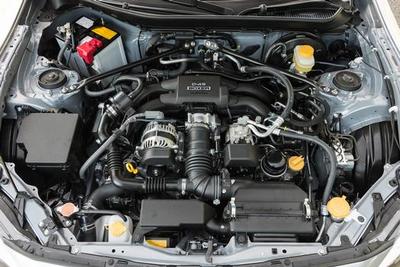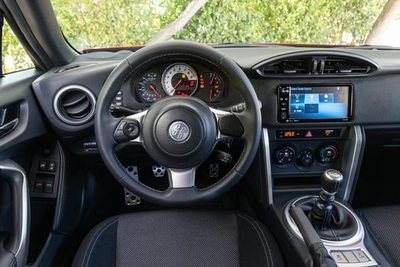2017 Toyota 86 Ride and Review By John Heilig +VIDEO
THE AUTO PAGE
By John Heilig
Senior Editor
Mid-Atlantic Bureau
The Auto Channel
REVIEWED MODEL: 2017 Toyota 86
ENGINE: 2.0-liter boxer 4
TRANSMISSION: 6-speed manual
HORSEPOWER/TORQUE: 205 hp @ 7,000 rpm/156 lb.-ft. @ 6,400 rpm
WHEELBASE: 101.2 in.
LENGTH X WIDTH X HEIGHT: 166.7 x 69.9 x 50.6 in.
TIRES: P215/45R17
CARGO CAPACITY: 7 cu. ft. (est.)
ECONOMY: 21 mpg city/28 mpg highway/23.2 mpg test
FUEL TANK: 13.2 gal.
CURB WEIGHT: 2,774 lbs.
TOWING CAPACITY: Not recommended
COMPETITIVE CLASS: Subaru BRZ, Nissan Z, Volkswagen GTI
STICKER: $31,544 (includes $865 delivery, $4,424 options)
BOTTOM LINE: The Toyota 86 is a complete 2+2 sports car, with great handling, a raucous exhaust, and great looks.
When Toyota 86-ed the Scion brand, they had a problem. What to do with one of Scion’s iconic models, the FR-S sports coupe? The solution was to rename it the Toyota 86.
The 86 name is revered among Toyota aficionados. AE86 was the global name for the Corolla GT-S of the mid-1980s. And fortuitously, the 2.0-liter boxer engine in the FR-S just happened to have bore and stroke dimensions of 86 mm x 86 mm. The exhaust tips also are 86 mm in diameter, so there’s a lot of symmetry with the model. Also, the 86 has just about the coolest logo around, and there are 86 badges all over the car, even on the headlights.
I was fortunate enough to be able to drive the FR-S when it was introduced in Las Vegas. We drove the car through slalom courses on the Las Vegas Motor Speedway race track as well on roads in the surrounding desert. Needless to say, we had a ball.
Also, when Toyota re-introduced the car as the 86, I was again fortunate to drive it in the mountains of California. My co-driver and I had a blast playing with the car on some interesting winding roads north of Ojai. So I was excited to revisit the car when I had a chance for a longer ride.
The two versions of the car I drove earlier had the standard exhaust and suspension, which were fine enough for spirited driving. The version I received for my “soak” test, however, had a Toyota Racing Development (TRD) exhaust system ($1,000), sway bar ($550) and lowered springs ($639). And while the combination made for better handling (probably more than my meager talents could make full use of) it also made for a harsher ride and ridiculously noisy exhaust.
With the exhaust, it was difficult to carry on a decent conversation inside the car. Forget about listening to the radio. Okay, I’ll admit that there may be a generational problem here, but older people are in the demographic mix for this car, too. (Maybe the impossibility of having a voice conversation encourages texting...)
Front seats are comfortable with a lot of good side support. With excellent handling, you want good seats to help hold you in place while you’re playing with the corners. The seats are Recaro-like but without the labeling, so I expect they are Toyota’s version of the iconic manufacturer. Rear seats, on the other hand, are more of an afterthought, as if they are there so Toyota can claim the 86 as a four-seater. It would probably be best to lower the seat backs to create a larger trunk, since without the assistance, the trunk is pretty miniscule. Again, to be fair, the trunk in my MGs, was at least as small, maybe smaller. However, entry and egress is a challenge for senior citizens.
With the 2.0-liter boxer-style engine rated at 205 horsepower (200 with the automatic transmission), acceleration is very good. It could have been better if I had been more willing to endure the exhaust note and annoy every other car around me. Thanks to solid power and torque, it is possible to stay in a higher gear on longer runs, which is desirable because of the loud exhaust. The shifter for the 6-speed manual transmission is fun to use, with short quick shifts.
Handling is very good with the uprated suspension. Again, I wasn’t disappointed with the base version. The expense is a rough ride on all but the smoothest roads. Steering is quick, and we used it to good advantage with some quick U-turns on narrow streets.
In its conversion to the 86, the FR-S received more aggressive styling with a larger center intake emphasizing the low, wide stance of the car. LED running lights and brake lights have become almost standard since the original introduction of the car and they add to the appearance.
The instrument panel is simple and functional. In the center is a large tachometer with an inset digital speedometer. Off to the left is an analog speedometer, but it is shrouded and difficult to read. While the 86 has a good suite of safety goodies, some were missing and needed. For example, a blind spot monitor would help, as would a rear cross traffic alert. Since the 86 is a small car, you can’t see a lot of what you might be able to see in a larger car.
My luck continues to hold out. If you’re in drought conditions, schedule me into a convertible and you can be assured of rain. The day after the 86 was delivered we had the heaviest snowfall of the winter, and I had to wait for a couple of days before I could really enjoy the car.
The 86 is a very good sports coupe. For my tastes, though, the ride with the TRD suspension is harsher than necessary and exhaust way too noisy.
The Most In-Depth Independent Toyota Vehicle Consumer Research - Anywhere!
- Toyota Buyers Guide | Specs, Prices, Expert Reviews and Comparisons 2018-1997
- Find Your Perfect New Vehicle Match
- Toyota Reviews From The Auto Channel (1993-Present)
- The Auto Channel's Toyota Brand Archives; News, Press Releases, Reviews, Specifications, Prices, Video, Images (71,117 Annotations)
(c) 2017 The Auto Page Syndicate





